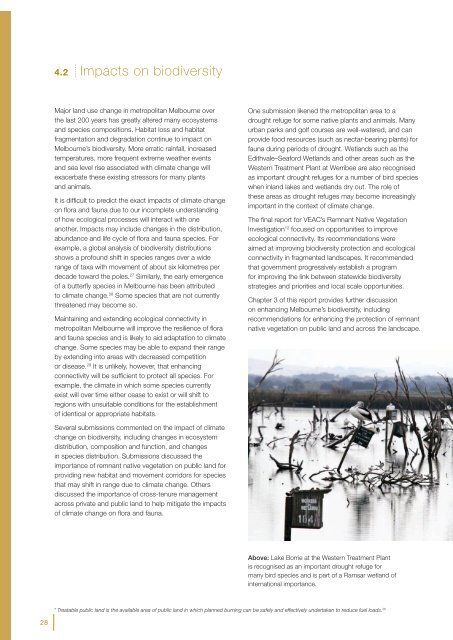Metropolitan Melbourne Investigation - Victorian Environmental ...
Metropolitan Melbourne Investigation - Victorian Environmental ...
Metropolitan Melbourne Investigation - Victorian Environmental ...
You also want an ePaper? Increase the reach of your titles
YUMPU automatically turns print PDFs into web optimized ePapers that Google loves.
4.2 Impacts on biodiversity<br />
Major land use change in metropolitan <strong>Melbourne</strong> over<br />
the last 200 years has greatly altered many ecosystems<br />
and species compositions. Habitat loss and habitat<br />
fragmentation and degradation continue to impact on<br />
<strong>Melbourne</strong>’s biodiversity. More erratic rainfall, increased<br />
temperatures, more frequent extreme weather events<br />
and sea level rise associated with climate change will<br />
exacerbate these existing stressors for many plants<br />
and animals.<br />
It is difficult to predict the exact impacts of climate change<br />
on flora and fauna due to our incomplete understanding<br />
of how ecological processes will interact with one<br />
another. Impacts may include changes in the distribution,<br />
abundance and life cycle of flora and fauna species. For<br />
example, a global analysis of biodiversity distributions<br />
shows a profound shift in species ranges over a wide<br />
range of taxa with movement of about six kilometres per<br />
decade toward the poles. 27 Similarly, the early emergence<br />
of a butterfly species in <strong>Melbourne</strong> has been attributed<br />
to climate change. 28 Some species that are not currently<br />
threatened may become so.<br />
Maintaining and extending ecological connectivity in<br />
metropolitan <strong>Melbourne</strong> will improve the resilience of flora<br />
and fauna species and is likely to aid adaptation to climate<br />
change. Some species may be able to expand their range<br />
by extending into areas with decreased competition<br />
or disease. 29 It is unlikely, however, that enhancing<br />
connectivity will be sufficient to protect all species. For<br />
example, the climate in which some species currently<br />
exist will over time either cease to exist or will shift to<br />
regions with unsuitable conditions for the establishment<br />
of identical or appropriate habitats.<br />
One submission likened the metropolitan area to a<br />
drought refuge for some native plants and animals. Many<br />
urban parks and golf courses are well-watered, and can<br />
provide food resources (such as nectar-bearing plants) for<br />
fauna during periods of drought. Wetlands such as the<br />
Edithvale–Seaford Wetlands and other areas such as the<br />
Western Treatment Plant at Werribee are also recognised<br />
as important drought refuges for a number of bird species<br />
when inland lakes and wetlands dry out. The role of<br />
these areas as drought refuges may become increasingly<br />
important in the context of climate change.<br />
The final report for VEAC’s Remnant Native Vegetation<br />
<strong>Investigation</strong> 12 focused on opportunities to improve<br />
ecological connectivity. Its recommendations were<br />
aimed at improving biodiversity protection and ecological<br />
connectivity in fragmented landscapes. It recommended<br />
that government progressively establish a program<br />
for improving the link between statewide biodiversity<br />
strategies and priorities and local scale opportunities.<br />
Chapter 3 of this report provides further discussion<br />
on enhancing <strong>Melbourne</strong>’s biodiversity, including<br />
recommendations for enhancing the protection of remnant<br />
native vegetation on public land and across the landscape.<br />
Several submissions commented on the impact of climate<br />
change on biodiversity, including changes in ecosystem<br />
distribution, composition and function, and changes<br />
in species distribution. Submissions discussed the<br />
importance of remnant native vegetation on public land for<br />
providing new habitat and movement corridors for species<br />
that may shift in range due to climate change. Others<br />
discussed the importance of cross-tenure management<br />
across private and public land to help mitigate the impacts<br />
of climate change on flora and fauna.<br />
Above: Lake Borrie at the Western Treatment Plant<br />
is recognised as an important drought refuge for<br />
many bird species and is part of a Ramsar wetland of<br />
international importance.<br />
* Treatable public land is the available area of public land in which planned burning can be safely and effectively undertaken to reduce fuel loads. 26<br />
28
















